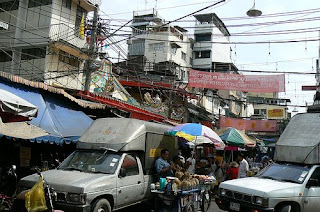
There are many Chinatown almost in very countries. There is one in San Francisco, South Africa, Australia, the Netherlands, United Kingdom and ever in Dubai. Almost every major country outside of China has a Chinatown. Thailand has one of the oldest Chinatown in the world along with Nagasaki in Japan.
HOW TO GET THERE
The easiest way to visit Chinatown is via the Chao Phraya riverboat. The nearest pier is teh Ratchawong Pier at the end of Ratchawong Road. This route will take you to the heart of old Chinatown, Soi Sampheng, the bithplace of Chinese community. You can also visit Yaowarat via MRT (subway), the nearest station is Hua Lam Phong station.
WHAT TO DO
The casual tourist on a daytrip in Chinatown would probably only have the time and energy to cover the main street, Yaowarat Road itself. Where most of the activities take place. The the road of interest is Ratchawong Road located off Yaorawat Road. Here one can stroll along and view locals eating, trading, and going about the lives.
The previous area named the Thieves Market or Nakhon Kasem is now a second hand market for Thai and Chinese antiques and pawnshop goods. Most are fakes, but look great, almost similar with the original. Once upon a time this place was where stolen goods would turn up, but you are now unlikely to find anything illigitimate today. Only the best bargainers should shop here, this place is good for a visit too.
If you would like to find gold, all along Yaowarat Road you will find over 130 gold shops. It is why this street also called "the Golden Road". Originally, there were a tycoon gold shop, Seng Heng Li, Hua Seng Heng, Tung Jin Aeng and Tung Toh Gung. Most shops along the road are members of the Gold Merchants Association. Gold products here are recognised for their high standard and quality with the purity of 96.5% or approximately 23 karat gold.
The Chalermkrung Royal Theatre (Sala Chaloem Krung)stages classic dramas and perfomances for those looking for a bit of cultural entertainment. King Rama VII using his own money, due his love of cinema, staed the theatre over 70 years ago. At the time it was built the theatre was the largest and most modern entertainment centre in Asia. It underwent major renovation in 1992, helping it to become a modern theatre of international standards. It is now equipped with the latest special effects and technologies such as laser and multi-vision systems which help to enchance the traditional elements of the stage shows and films.
For the first time visitor should visit the Giant Swing. It was originally constructed in 1784. The swing has been rebuilt numerous times throughout the years. REcently the swing was rededicated in royal ceremony prisided over by His Majesty King Bhumibol Adulyadej in Semtember 2005, the Giant Swing together with Wat Suthat, was suggested as a future UNESCO World Heritage Site.
Not far from Yaowarat is the Pahurat cloth market, in "Bangk Little India" situated next to Chinatown. It is basically a wholesale market fot textiles.
While you walk around, you may see many food stall. Almost all are Chinese food... ut you must try it because this is unique Chinese food only can be found in Thailand. Mixed with Thai flavour. And also there are many unique dishes you may taste.
All in Chinatown there are many fascinating view worth to be visited and seen into Thailand of old and present Chinese community. The narrow lanes and interesting architectures stand in contrast to modern highrises buildings. Come and visit Yaorawat with the whole your heart and you;ll see its uniqueness..





No comments:
Post a Comment